
Crystal City, Texas
 Aerial view
|
 Housing
|
 Monument
|
Oct. 18, 1943 Letter about Crystal City camp
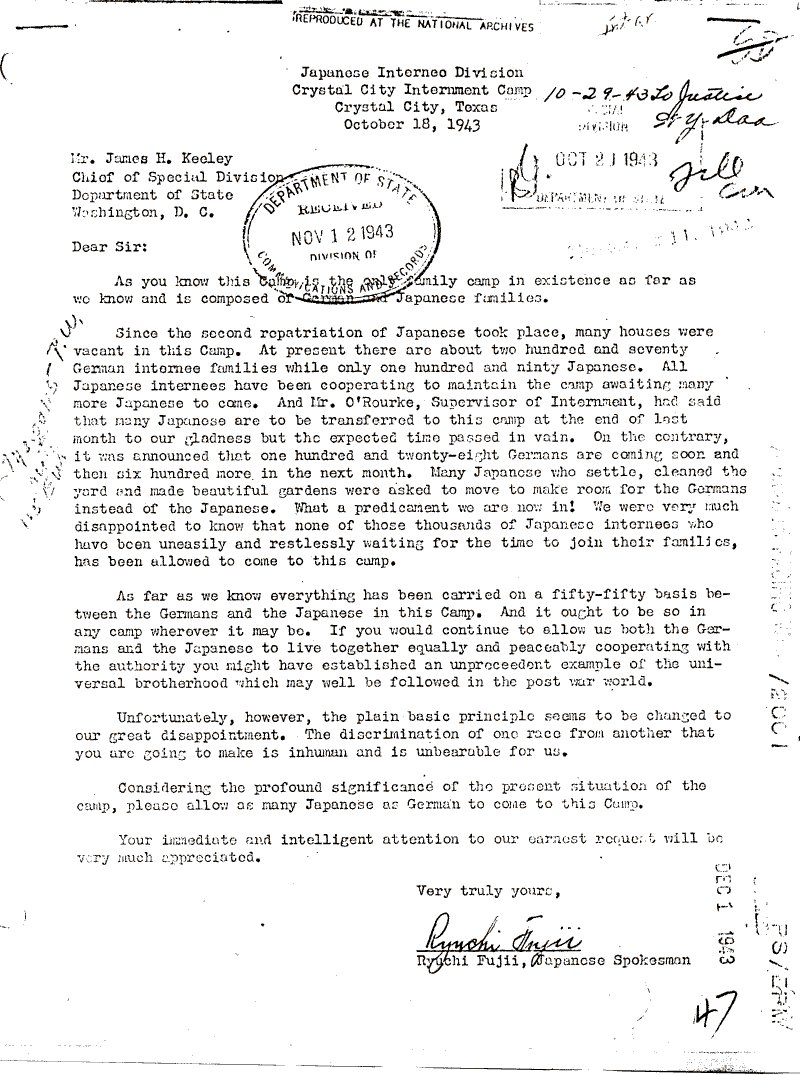
The camp opened in November of 1942.
This was a former migrant farm labor camp. It could hold up to 3,500 people. It was a rare camp in that it held 35 German aliens and their families, arriving in December of 1942. Japanese resident aliens arrived in March of 1943, and the camp was divided into two sections for the two different groups.
The population reached 4,000, 2/3rds of them people of Japanese ancestry. 600 were from Hawaii and 600 from Peru. The camp did not close until late in 1947. Peru did not want them back; they did not want to go to Japan;the U.S. claimed they were illegal immigrants (even though it was the U.S. that arranged for them to be moved from Peru to the U.S.), but eventually they found employement with Seabrook Farms in New Jersey.There is a monumejt and the camp site is owned by the school district.

Nevada State Journal, Nov. 23, 1944
Crystal City Internment Camp 1945 from You Tube
Crystal City Interment Camp 1945
"A video made from a public domain film produced by the Immigration and Naturalizaton Service in 1945 of the family internment camp at Crystal City, Texas. This camps was used for the incarceration of German Americans, German Latin Americans, Italian Americans and Italian Latin Americans, as well as Japanese Americans and Japanese Latin Americans."" From: CrystalCity1945 .
This is a rare film, as in all my research I've done so far I haven't found this one anywhere else. Films on the individual camps are not common; Manzanar seems to have the most coverage. I have not reproduced all the words. Some of the words are lost, also. It's an old film and that's to be expected.
 |
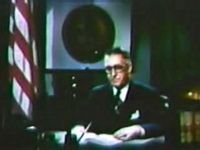 |
The guy starts out talking about how the Dept. of Justice was responsible for detention of enemy aliens.
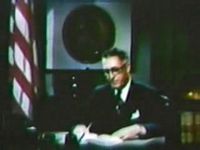 |
He then talks about how the film of Crystal City will show how people "lived, worked and played" under "traditional American standards of decent and humane treatment." (So, how was it "traditional" and "decent" American standards to lock up 120,000 people without any formal charges, trials, or rights of legal representation?)
"Here is a party of women and children arriving in Crystal City. Following their voluntary decision to join husbands and fathers in detention."
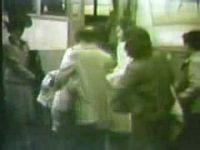 |
"Practically all the children and many women were American born."
 |
"...the welcoming committee and band music." (The opening words are lost.) "New arrivals and their baggage were examined by inspectors and matrons." Then there's else missing, but I think it was something about valuables because the next part is about things being put into safes and detainees being given receipts.
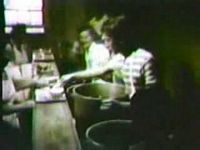 |
"Following the admission procedure they were fed in the central mess. They were then escorted to quarters which were assigned in advance of their arrival."
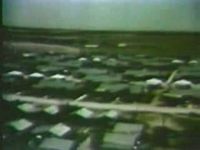 |
"The sun shines practically every day in the year, with a cool breeze from the Gulf in the evening. Originally it was a migratory labor camp of approximately 100 housing units, utility and recreation buildings. To provide for a population of 3600
we added more than 500 housing units, (a) school building, a hospital, administrative and maintenance buildings. We tripled the number of streets, and extended electric and sewage facilities."
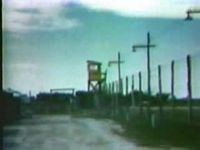 |
"This is the perimeter over armed guards kept a twenty-four hour watch."
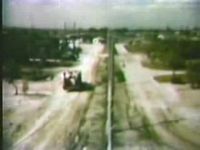 |
"At night the illumination from the lights at the top of this fence was visible almost to the Mexican border."
 |
"Both groups cultivated flowers with great pride. Seeds were purchased by them with their own money. They also built and paid for the screen porches you see."
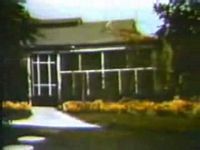 |
"For such items which were considered morale builders they could draw on their personal funds. Each housing unit was furnished with running water, an icebox, beds and linen, (a) chair, and some with toilet facilities. Community showers and latrines were located throughout the area."
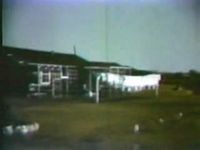 |
"People who had to be isolated for medical purposes were placed in cottages like this which were equipped with modern conveniences. There were about fifty of these in the area."
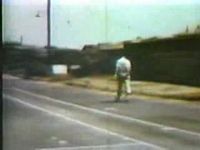 |
"This is one of the community bath houses."
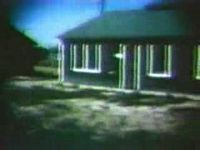 |
"This is the way the houses appeared before the detainees made homes out of them."
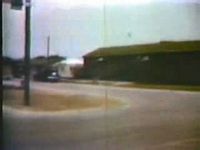 |
"There are the central administration buildings. Supervised repatriation movements, investigations, releases and paroles, allocated housing. Another important office was supply and procurement. Foodstuffs were checked into the supply warehouse and then rationed according to a formula based upon the normal needs and size of the family."
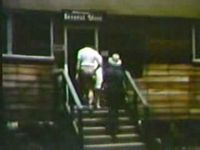 |
"Detainees were issued plastic money each month with which they could purchase these foodstuffs in the facility store. The system was economical and practical as it was..." (The rest of the sentence is missing.)
 |
"There is a mail truck being checked in."
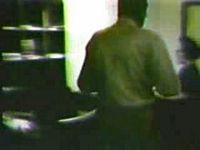 |
(words missing)"...used for security purposes. Few limitations were placed upon the number of letters which could be sent or received. Mail was delivered to the internal security office where it was examined by German, Spanish, and Japanese censors."
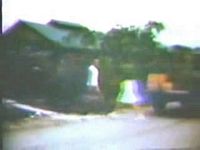 |
"The daily milk delivery. At one time there were sixteen hundred minor children in detention. Twenty five hundred quarts of milk were required."
 |
uired each day.”
(again, words missing)"...the grounds. There are the public health officer and head nurse. Ills were often imaginary, traceable to detention, the fence, the loss of freedom. As many as sixty patients were treated daily in the clinic. Japanese and German girls were trained by the public health nurses as aides, were faithful and dependable helpers."
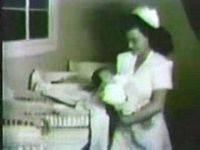 |
"Young America. About two hundred and fifty Americans were born in this hospital."
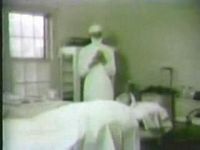 |
"This is the operating room. There were five detainee doctors in the facility, two of whom were Japanese women."
 |
"Detainees exchanging the latest rumors and making calls."
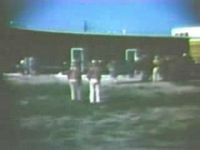 |
"This is the German recreation center. There was a small cafe in this building called the (?) where they enjoyed music furnished by their own orchestra."
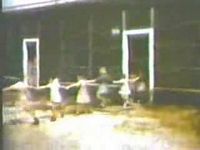 |
"The kindergarden was at one end of this building."
 |
"Here are some children at play under the direction of a detainee teacher."
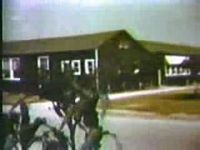 |
"Here is the American grammar and high school which was accredited by the Texas State Board of Education. Many graduates from this high school went on to college following their release from detention. The Japanese required their children to attend the American school in the morning and the Japanese school in the afternoon."
 |
"There is the Japanese school. Directly in back of those children is a Japanese recreation center. Carefully selected movies were shown each week in the two recreation halls."
 |
"This swimming pool was originally an irrigation tank for the farm. Seepage of water in the vicinity of the tank caused mud holes and unsanitary conditions so it was necessary to wall it in with concrete. This was done by the detainees at a cost to the government of about twenty-five hundred dollars. This tank was not only of vital importance to the farm for irrigation purposes and essential to hygiene and sanitation, but it helped greatly to relive the monotony of detention for teenagers and adults."
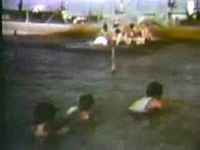 |
"And, as you see, it was particularly beneficial to the children."
Crystal Camp
The source of the article can be found here.
What I will do here is just summarize the major points of the article.
1. The first internees arrived on December 12, 1942 and were German.
2. On February 12, 1943, Germans from Latin America arrived.
3. On March 17, 1943, the first of the Japanese Americans arrived.
4. The camp's top population was 3,374, around 67% of which were persons of Japanese ancestry.
5. Some Germans and Italians from Latin America were added to the camp later.
6. Once Italy surrendered in 1943, the Italians were allowed to leave.
7. Crystal City concentrated on housing families together.
8. Details in the Third Geneva Convention dictated much of how a camp was supposed to be put together.
9. The camp was, like almost all the others, surrounded by a barbed wire fence.
10. No one was required to work (Third Geneva Convention) but, if they wanted to, there were lots of jobs in the map available. The camp seemed to have lots of stores, more so than the average camp.
11. Schools included a school for Japanese, one for Germans, and one for Americans.
12. In 1944 and 1945 many internees were shipped back to Japan and to Germany.
13. Peru didn't want their Japanese citizens back.
14. The camp closed on February 27, 1948.
Three Little Heard-of Internment Camps
I'll summarize a good article on the two camps here.
1. Kooskia was run by the INS.
2. It was a hodge-podge of internees, consisting of persons of Japanese ancestry, Germans and Italians.
3. 80% of the prisoners were from Peru.
4. Around 70% in the camp were persons of Japanese ancestry.
4. The Seagoville Internment Camp was run by the Bureau of Prisons. Compared to the other camps this one was quite lush.
5. The Kennedy Alien Detention Camp was only for men.
6. It eventually ended up as a camp for injured German POWs.
7. Crystal City was run by the INS and the Department of Justice. It ended up housing persons of Japanese ancestry, Germans, and Italians. It was also more nicely arranged than the average camp.
8. The camp had a variety of schools for the persons of different nationalities.
9. When the camps shut down Peru refused to take back their persons of Japanese ancestry. Some went back to Japan and the others went to Hawaii.
The article is on the Texas State Historical Association site.
Main Index
Japan main page
Japanese-American Internment Camps index page
Japan and World War II index page
|
|